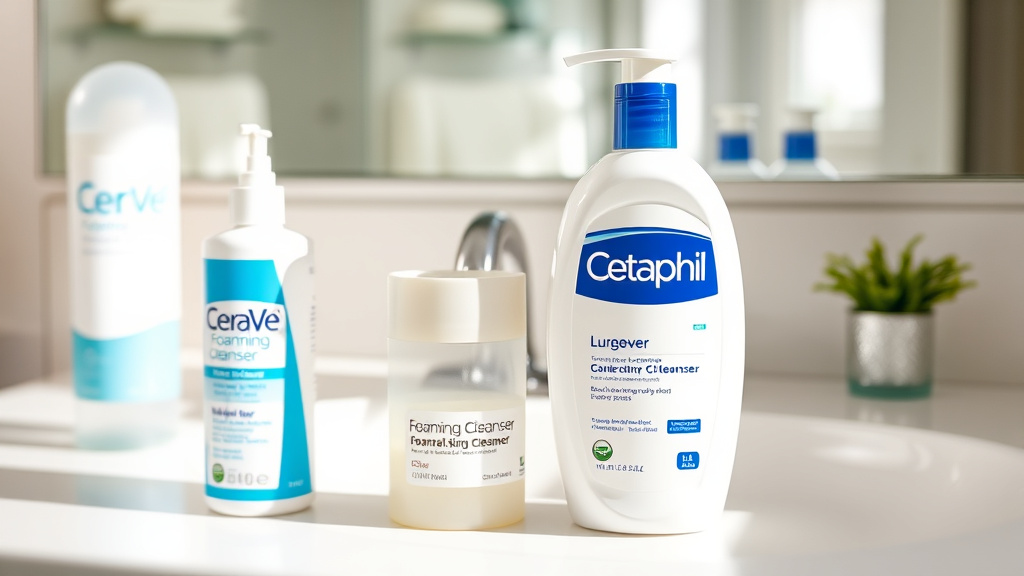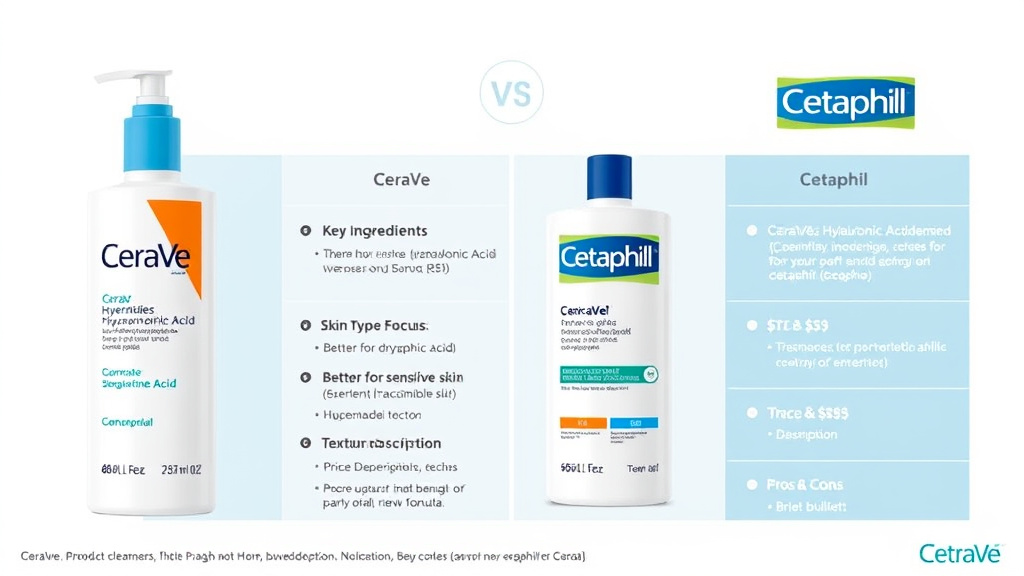When it comes to drugstore skincare, few debates are as persistent and as significant as CeraVe vs Cetaphil. Both brands are widely recommended by dermatologists and are known for their gentle yet effective formulations, making them popular options for those with sensitive, dry, or oily skin. If you’re searching for the best facial cleanser 2025, chances are you’ve encountered these two giants. But which one truly suits your skin type and concerns? In this comprehensive guide, we’ll explore the backgrounds, key ingredients, pros and cons, and real-world comparisons of CeraVe cleanser review and Cetaphil cleanser review to help you make an informed choice.
Understanding the differences between CeraVe vs Cetaphil is crucial because these brands have distinct philosophies, ingredient strategies, and textures that cater to various skin needs. Both are considered drugstore face cleansers, accessible and affordable options that have earned their place in many skincare routines. However, subtle differences in formulation can impact how well they work for you, especially if you have specific concerns such as sensitivity or acne-prone skin. Let’s dive deeper into their origins and what makes each brand unique.
Brand Backgrounds (CeraVe Cetaphil)

History and Philosophy
CeraVe was developed with the expertise of dermatologists and skincare scientists, emphasizing the importance of restoring and maintaining the skin’s protective barrier. Its formulations focus heavily on ceramides—lipids naturally found in healthy skin—and hyaluronic acid, which helps with hydration. Launched in 2005, CeraVe’s approach was rooted in scientific research aiming to support compromised skin, such as eczema and psoriasis, making it a favorite for sensitive and dry skin types.
In contrast, Cetaphil, launched in the 1940s, has a longer history and a philosophy centered around simplicity and gentleness. Its products are designed to be mild enough for even the most sensitive skin, including those with allergies or intolerances. Although less focused on specialized ingredients like ceramides, Cetaphil emphasizes the importance of maintaining the skin’s natural pH and barrier with minimal irritation, making it a popular choice for all skin types, especially sensitive skin.
Dermatologist Reputation
Both brands enjoy strong dermatologist endorsements, although it’s worth noting that dermatologists often recommend CeraVe for dry and compromised skin conditions due to its barrier-restoring ingredients. Cetaphil, on the other hand, has a long-standing reputation for being extremely gentle, making it a trusted choice for sensitive and irritated skin. When we compare CeraVe vs Cetaphil, they both shine in terms of medical backing, but CeraVe’s scientific formulation might appeal more to those seeking targeted barrier support.
CeraVe Cleanser Review
Key Ingredients
The CeraVe cleanser review highlights its unique blend of ceramides, hyaluronic acid, and glycerin. Ceramides are essential lipids that help repair and protect the skin’s barrier, which is especially beneficial for dry or sensitive skin. Hyaluronic acid enhances hydration by attracting moisture, leaving the skin feeling refreshed without tightness. Glycerin, a powerful humectant, supports moisture retention making it a gentle cleanser that cleans without stripping.
Best Skin Types
This cleanser is ideal for dry, sensitive, or compromised skin types that need gentle yet effective cleansing. Its non-foaming, gel-based texture suits those with a fragile barrier or prone to reactions. It’s also suitable as part of a barrier-first routine in dry or sensitive skin, especially when combined with products like barrier repair creams that contain ceramides.
Pros Cons
Pros include:
- Rich in ceramides and hyaluronic acid, supporting barrier health
- Gentle, fragrance-free formula suitable for sensitive skin
- Non-irritating and hydrating
Cons include:
- Slightly less effective at deep pore cleansing for oily or acne-prone skin
- Might feel too mild for those needing a more robust cleanse
Cetaphil Cleanser Review
Key Ingredients
The Cetaphil cleanser review emphasizes its core gentleness, with formulations predominantly containing glycerin and, in newer variants, niacinamide. Glycerin hydrates the skin, while niacinamide can support skin barrier function and reduce redness. Cetaphil’s classic formulas avoid harsh surfactants, making them suitable for sensitive skin and allergens.
Best Skin Types
Cetaphil cleansers work well for all skin types but are particularly effective for sensitive, dry, or irritated skin. If you prefer a very mild, no-fuss routine, this is a trustworthy choice. Those with sensitive skin appreciate the lack of fragrance and minimal ingredients, helping prevent reactions.
Pros Cons
Pros include:
- Exceptionally gentle and safe for daily use
- Suitable for allergy-prone skin
- Widely available at drugstores
Cons include:
- Some formulas may not thoroughly clean excess oils for very oily skin
- Less focus on barrier-restoring ingredients like ceramides (unless you opt for newer formulas)
CeraVe vs Cetaphil: Side-by-Side Comparison

Texture Feel
CeraVe’s gel cleanser feels slightly thicker, with a rich, lotion-like consistency that glides smoothly over the skin, leaving a hydrated, refreshed feeling. Its foam may be minimal, emphasizing barrier protection rather than deep cleansing.
Cetaphil’s classic formulas tend to be more liquid or cream-like, with a very mild, silky feel. The texture prioritizes softness and simplicity, ideal for those who dislike tight sensations after cleansing.
Ingredients Benefits
While both are gentle cleansers, CeraVe stands out for its inclusion of ceramides and hyaluronic acid, which directly support skin barrier health and hydration. Conversely, Cetaphil mainly focuses on glycerin and soothing ingredients, prioritizing minimalism. Both brands avoid harsh surfactants, making them safe options for daily use.
Price Availability
Both are very accessible, affordable drugstore skincare options, often priced similarly. CeraVe may sometimes be slightly more expensive due to its specialized ingredients, but discounts and bundles make it a budget-friendly choice.
Dermatologist Opinions
Many dermatologists recommend CeraVe for its evidence-based ingredients that specifically support barrier repair, especially in dry or sensitive skin. Cetaphil is preferred for severe sensitivities or allergic reactions due to its minimalist formula. Ultimately, the choice may come down to personal skin needs.
Both cleansers are dermatologist-tested and widely available.
According to Healthline’s comparison of CeraVe vs Cetaphil, CeraVe’s formulas emphasize ceramides and hydration, while Cetaphil is often praised for sensitivity-friendly formulas.
A similar analysis by Verywell Health also highlights that CeraVe tends to be richer in barrier-repairing ingredients, whereas Cetaphil excels at being ultra-gentle and affordable.
Which Cleanser Should You Choose in 2025?
Selecting the right cleanser depends on your skin type and concerns. If you have dry or sensitive skin that needs hydration and barrier support, CeraVe may be the better choice. Its ceramides and hyaluronic acid can work synergistically to protect and restore your skin. For those with oily or acne-prone skin, a cleanser with salicylic acid or a stronger oil-control formula might be more suitable, but a gentle cleanser like CeraVe can still be effective if you prefer barrier protection.
For sensitive skin that reacts to many ingredients, Cetaphil’s minimalist, hypoallergenic approach offers peace of mind, with the added benefit of being an easy-to-use, safe daily cleanser. Both brands are good options, but your choice should align with your specific skin needs and routine preferences.
FAQs (CeraVe vs Cetaphil)
Can I use both cleansers?
Yes, if you have different needs at different times, or if you want to incorporate both into a routine—perhaps using CeraVe in the evening to support barrier repair and Cetaphil in the morning for a gentle start—that’s perfectly fine. Just make sure not to over-cleanse or strip your skin.
Which is better for acne?
Both brands are gentle but CeraVe may provide additional benefit for acne-prone skin due to its barrier-supporting ceramides and hyaluronic acid. However, for active acne, pairing either with targeted treatments like BHA exfoliants [explain BHA ranges] can improve results.
Are they safe for daily use?
Absolutely. Both CeraVe and Cetaphil are designed for daily cleansing, even multiple times a day. Adhering to recommended routines helps maintain skin health and prevent irritation, especially when combined with soothing ingredients like glycerin.
Conclusion
In the ongoing CeraVe vs Cetaphil debate, there’s no one-size-fits-all answer. CeraVe excels in barrier repair and hydration, making it a solid pick for dry, sensitive, or compromised skin, while Cetaphil offers unbeatable gentleness for those with highly sensitive or reactive skin. Both brands are leading choices for drugstore face cleansers in 2025, trusted by dermatologists and users alike. When choosing, consider your skin type and needs—either way, you’ll likely be opting for a gentle, effective cleanser that supports healthy skin. Remember, the best routine is the one that suits your skin’s unique requirements, combining gentle cleansing with appropriate hydration and barrier support.
Still unsure which cleanser suits your skin? Explore our Skincare Reviews Hub for more in-depth comparisons and dermatologist-backed insights.



